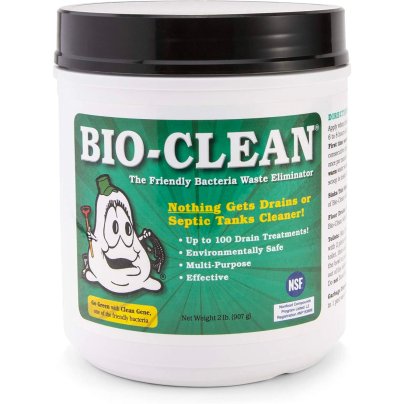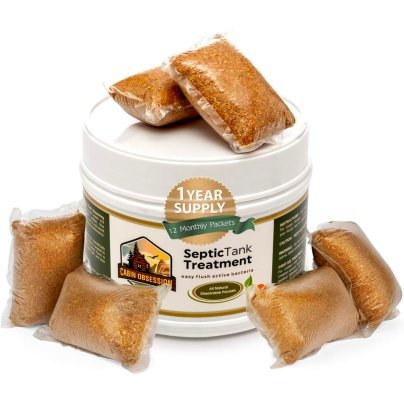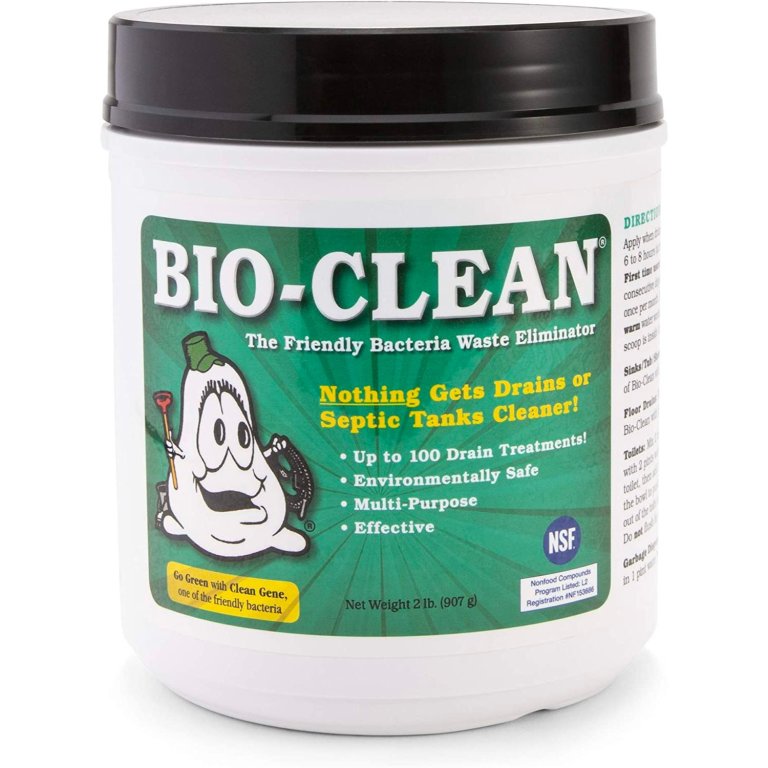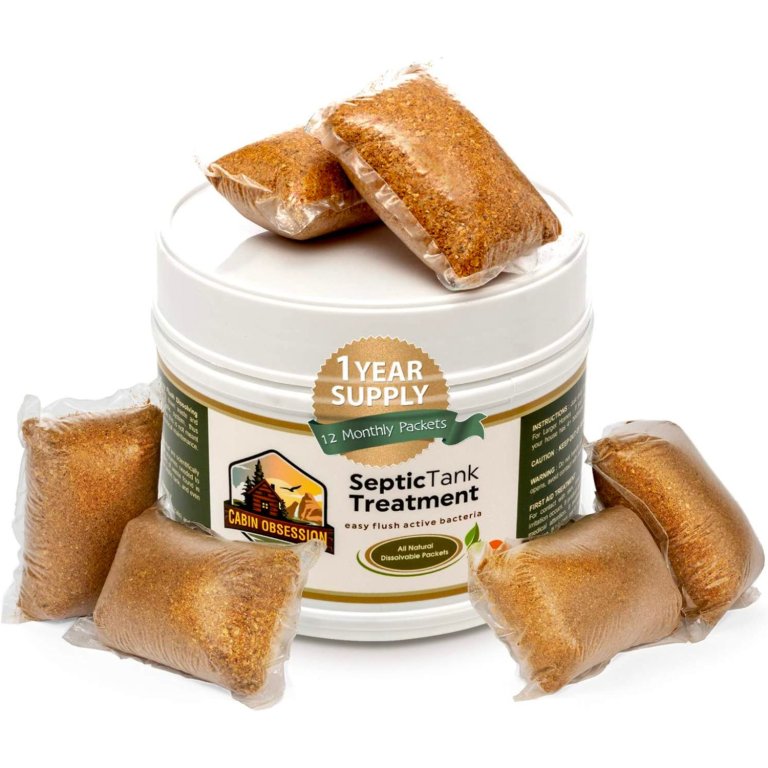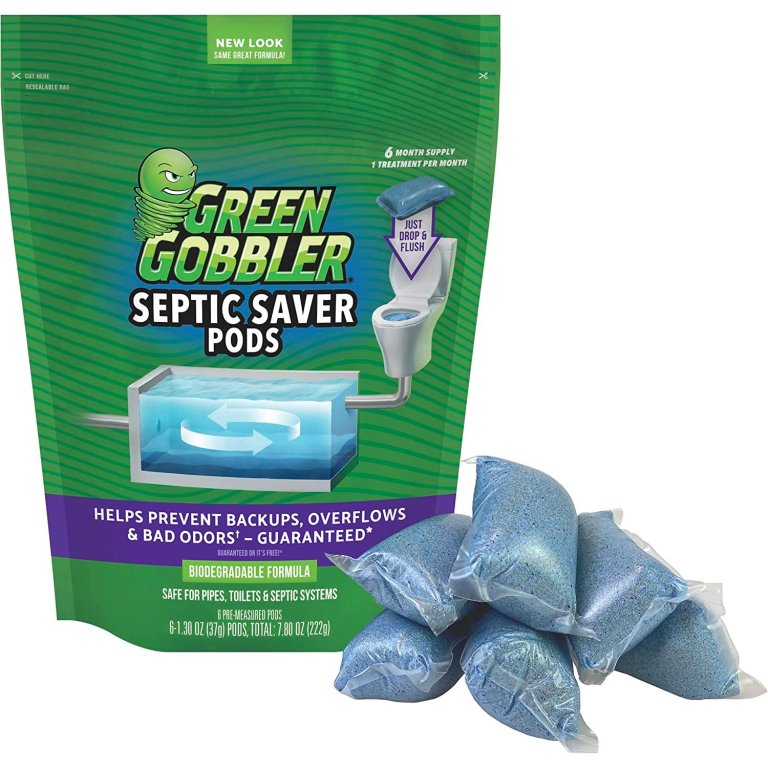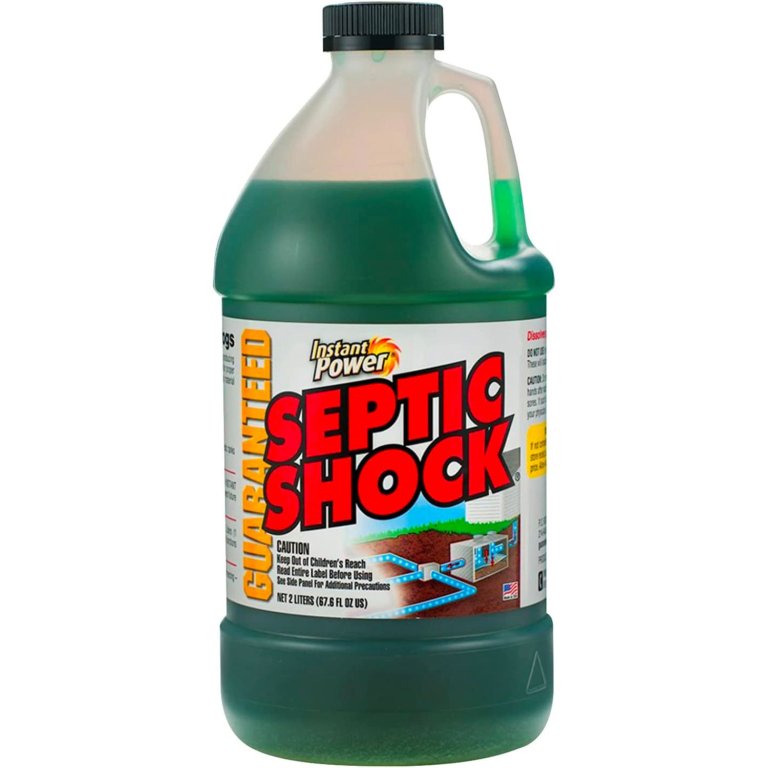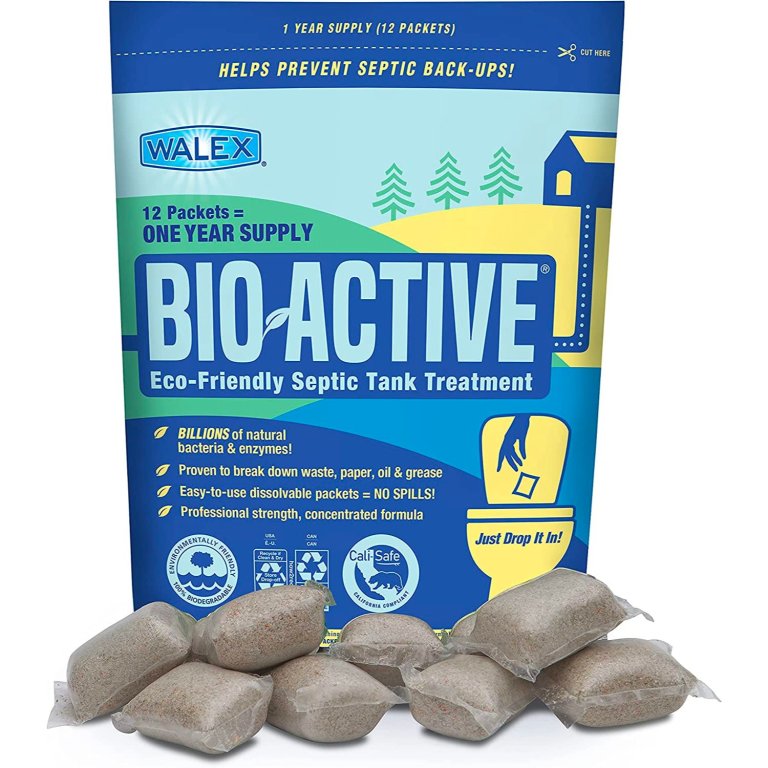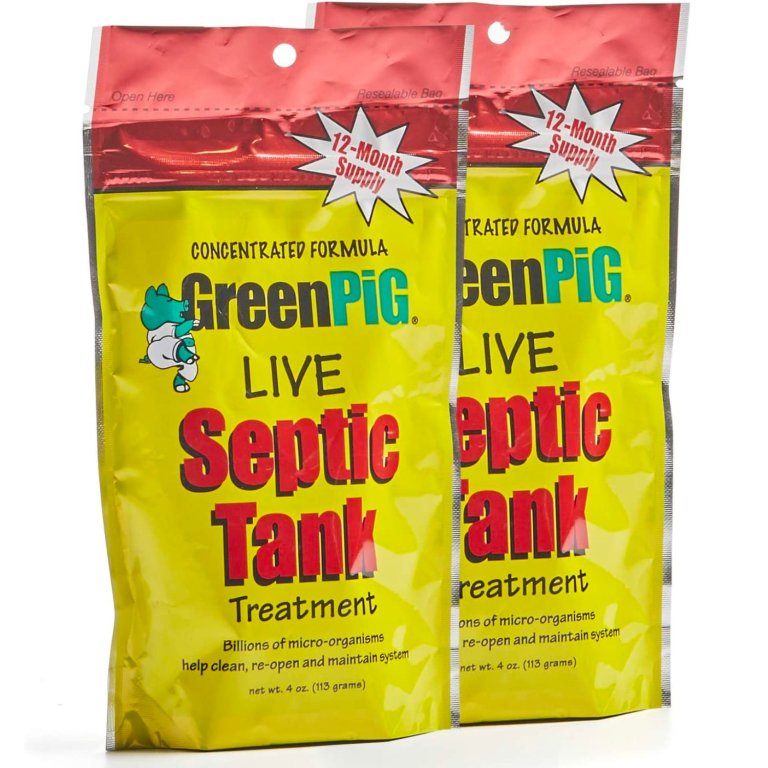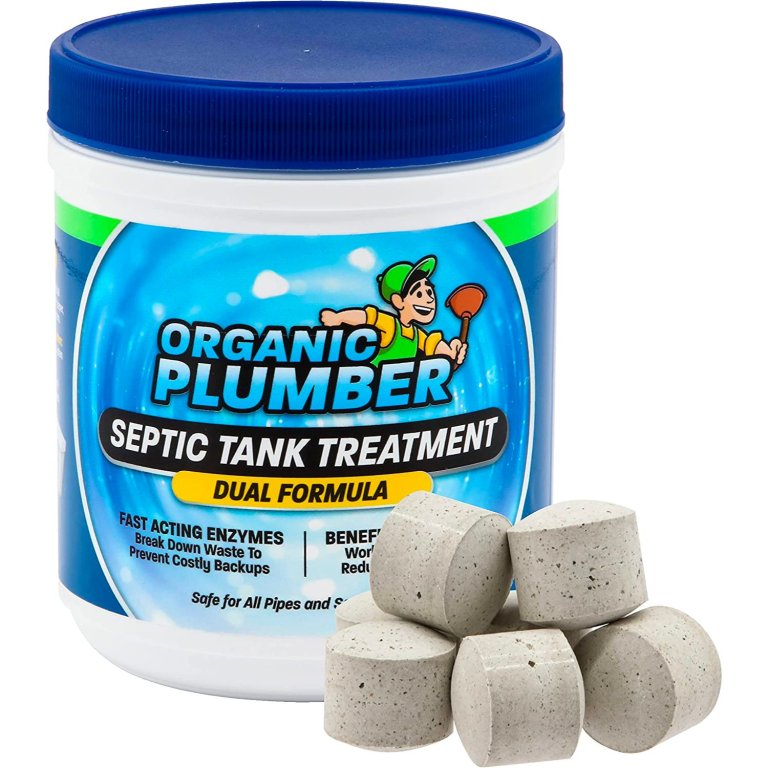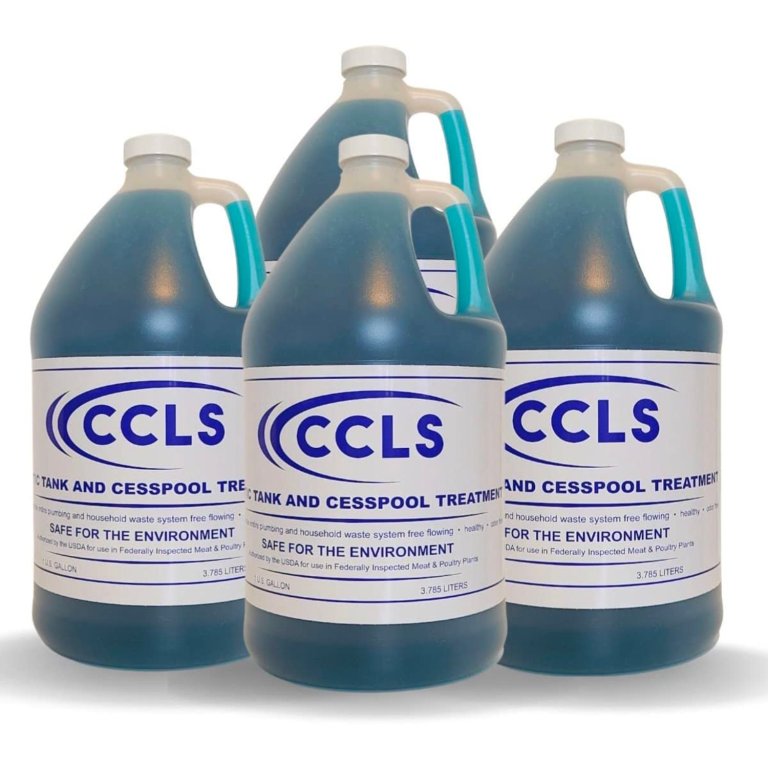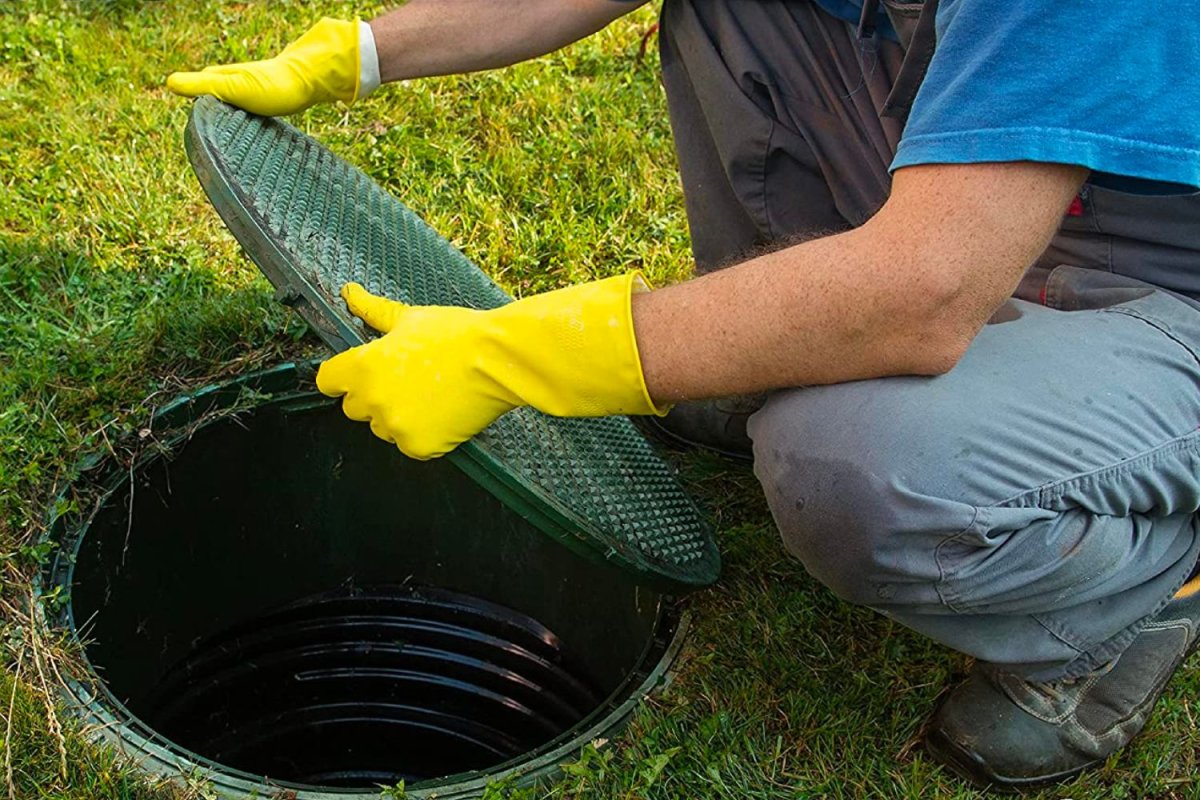
We may earn revenue from the products available on this page and participate in affiliate programs. Learn More ›
A septic system isn’t much good if it’s clogged, and once it is clogged, it’ll cost a fair amount to pump it—but using a septic tank treatment every so often can help prevent this. If you don’t already know, septic systems carry wastewater from the home into a tank, where active bacteria dissolve and consume waste, effectively separating it into solids and liquids. The liquids then drain through perforated pipes into a drain field, where the water is filtered and cleaned through layers of rock and minerals before returning to the groundwater system.
An impressive feat of engineering, a septic system still requires regular maintenance to function well. Using a septic tank treatment regularly is extremely helpful, as it provides the natural bacteria in the tank a boost to help it continue effectively degrading the household waste that enters the tank. Most of these products are easy to use, so you don’t need to be a plumbing expert to handle the task. For example, our overall favorite pick, Bio-Clean Drain Septic, only needs to be mixed with water and flushed down the toilet. Ease of use isn’t all there is to like about these products, though. Read on to learn why we selected the following formulations as the best septic tank treatments available in their respective categories.
- BEST OVERALL: Bio-Clean Drain Septic
↓ Jump to Review - RUNNER-UP: Cabin Obsession Septic Tank Treatment
↓ Jump to Review - BEST BANG FOR THE BUCK: Green Gobbler Septic Saver Pods
↓ Jump to Review - BEST FOR CLOGS: Instant Power Septic Shock
↓ Jump to Review - BEST MONTHLY: Walex Bio-Active Eco-Friendly Septic Tank Treatment
↓ Jump to Review - BEST BULK: GreenPig Live Septic Tank Treatment
↓ Jump to Review - BEST NATURAL: Organic Plumber Dual Formula Septic Tank Treatment
↓ Jump to Review - ECO-FRIENDLY PICK: CCLS Septic Tank and Cesspool Treatment
↓ Jump to Review
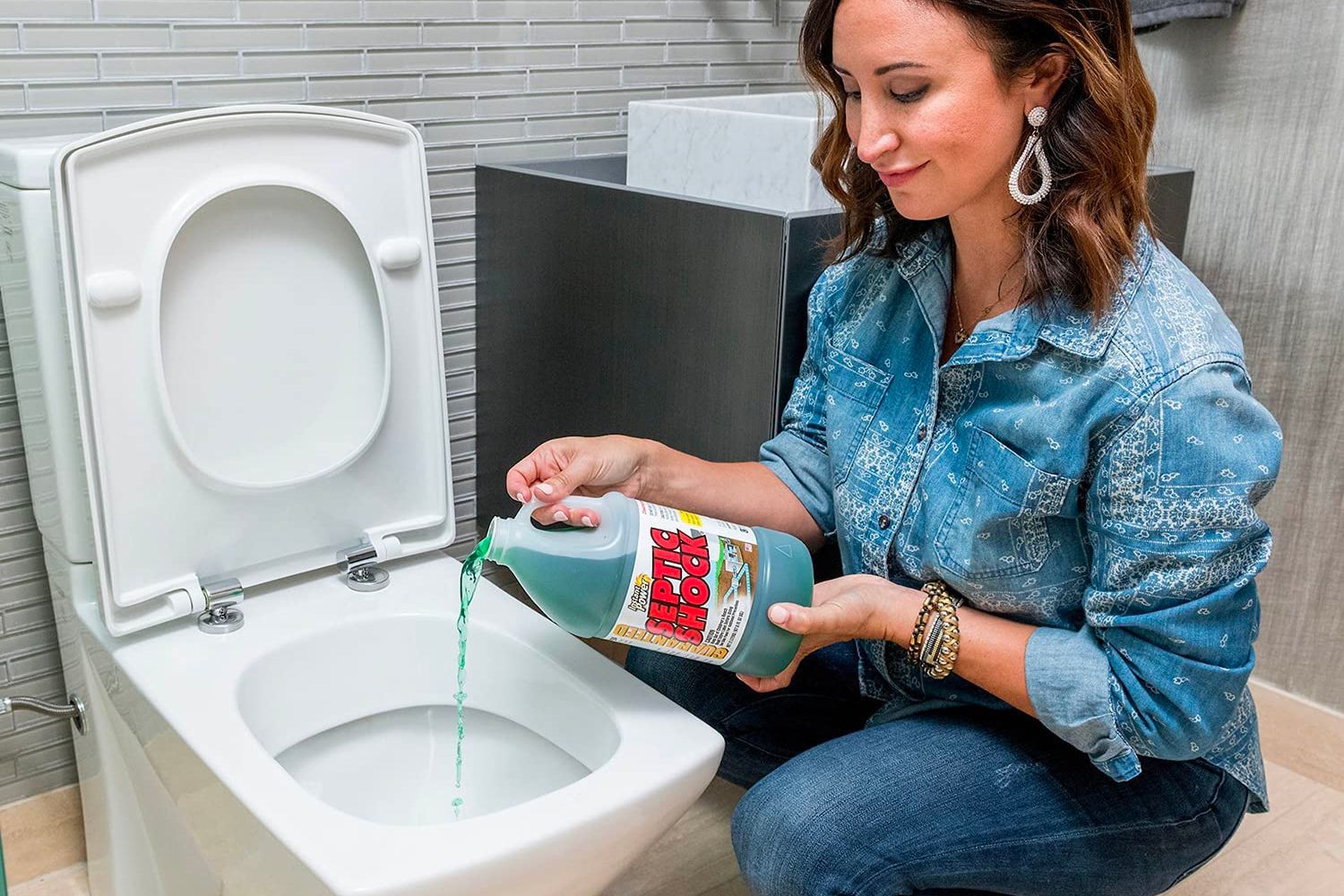
Before You Buy a Septic Tank Treatment
The right septic treatment must be compatible with your tank while so that it can effectively break down human waste, oils, and grease. Be sure to verify the treatment you’re considering is suitable for your tank, or you could potentially create more problems than you solve.
Our Top Picks
The following recommendations for the best septic tank treatments focus on varieties of biological additives. Septic tank professionals recommend this type over other options because they won’t damage the system or pollute soil or groundwater.
Best Overall
Bio-Clean Drain Septic
What We Like
- Highly effective in breaking down organic waste
- Works on septic tanks, grease traps, drain lines
- Environmentally friendly; safe to use around children, pets
What We Don’t Like
- Pricey, but effective
Product Specs
- Type: Biological additives
- Tank compatibility: 1,000-gallon tanks
- Lifespan: 1 month per cup
This pick from Bio-Clean is a natural septic tank treatment designed to maintain and improve the health of septic systems. This product contains a blend of bacteria and enzymes that are specifically formulated to break down and digest organic matter, including grease, oils, fats, and paper, which can clog septic systems over time. It is safe for all plumbing, including toilets, sinks, garbage disposals, and showers.
We appreciate just how simple it is to use this formulation. For the initial treatment, simply mix the entire contents of the jar with 4 gallons of water and flush the mixture down the toilet. Follow up by flushing 1 cup of the powder monthly.
Get the Bio-Clean septic tank treatment at Amazon or Walmart.
Runner-Up
Cabin Obsession Septic Tank Treatment
What We Like
- Each purchase includes a full year of treatments
- Also provides odor control
- No chemical additives
What We Don’t Like
- Treating larger septic tanks may require two pods
- Needs to be applied every month; not ideal
Product Specs
- Type: Biological additives
- Tank compatibility: 1,000-gallon tanks
- Lifespan: 1 month per pod
Cabin Obsession’s’ septic tank treatment comes with 12 prepackaged doses to be used in a 1,000-gallon tank on a monthly basis, totaling a full year of septic tank protection. The billions of bacteria in a single one of these septic tank treatment pods break down the waste in the sludge and scum layers, all while replacing dead bacteria within the tank.
This moderately priced eco-friendly treatment contains zero chemical additives, making it safe for the environment. The scientifically selected bacteria cultures also have odor-control qualities to keep your home smelling fresh. Do note that if your household has four or more occupied bedrooms, or your septic tank exceeds 1,000 gallons, you should use two pods per month instead of just one.
Get the Cabin Obsession septic tank treatment at Amazon or Walmart.
Best Bang for the Buck
Green Gobbler Septic Saver Pods
What We Like
- Provides odor control and anticorrosive capabilities
- Protects drains and pipes as well as tank
- Affordable 6-month supply of septic tank treatments
What We Don’t Like
- Incapable of clearing hair from the septic tank
Product Specs
- Type: Biological additives
- Tank compatibility: 1,500-gallon tanks
- Lifespan: 1 month per pod
Promising 6 months of ongoing septic system treatment, the affordable Green Gobbler Septic Saver pods use biodegradable content to ensure they’re safe for the environment. The powerful bacteria and enzyme mixture comes in pod form and effectively breaks down oils, grease, fats, paper, and other clog-producing compounds.
At a fraction of the cost of other septic tank treatments, it is surprising that the Green Gobbler septic tank treatment also has odor-elimination properties and anticorrosive additives to help protect drains, pipes, and the interior of the tank.
Get the Green Gobbler septic tank treatment at Amazon or Walmart (4-pack).
Best for Clogs
Instant Power Septic Shock
What We Like
- Dissolves grease, soap, paper, human waste, and fats
- Possesses odor-eliminating properties in addition to clearing clogs
- Organic solvent eliminates clogs with eco-friendly ingredients
What We Don’t Like
- For emergencies; doesn’t replace regular septic tank treatments
Product Specs
- Type: Organic solvent
- Tank compatibility: 1,500-gallon tanks
- Lifespan: As needed
Clogs are inconvenient, but this product was designed to clear them quickly and easily. Keep in mind that this powerful product should not be used as a regular septic tank maintenance treatment, as it is specifically engineered for clogs, and its contents may overpower a healthy septic system.
To use, simply dump all the contents of the bottle into the toilet and flush it down into the septic pipes. From there, it will begin to work instantly, and its odor-eliminating enzymes help prevent undesirable smells from permeating the home. We like that this formulation is eco-friendly, using lipase, protease, cellulose, alpha-amylase, and other powerful enzymes to digest grease, soap, paper, and fats—and all of this at an affordable price.
Get the Instant Power septic tank treatment at Amazon or The Home Depot.
Best Monthly
Walex Bio-Active Eco-Friendly Septic Tank Treatment
What We Like
- Full year’s worth of premeasured treatments
- Helps dissolve solids in the septic tank
- Safe to use in all plumbing systems
What We Don’t Like
- Some residue will be left behind after use and may require cleaning
Product Specs
- Type: Bacteria additives
- Tank compatibility: 1,500-gallon tanks
- Lifespan: 1 month per pod
Walex Bio-Active septic tank treatment comes with 12 moderately priced monthly doses, capable of effectively treating a 1,500-gallon tank with ease. The premeasured pods contain billions of good bacteria to replace bacteria in the tank that may have been killed by harmful cleaning products disposed of down sinks or toilets.
The eco-friendly pods also use septic tank-specific enzymes to target paper, fats, proteins, and other frequently occurring solid wastes that the bacteria within the tank cannot digest. This product can leave a residue on the toilet interior after use, so consider using it prior to cleaning the toilet to avoid repeatedly scrubbing the bowl.
Get the Walex septic tank treatment at Amazon or The Home Depot.
Best Bulk
GreenPig Live Septic Tank Treatment
What We Like
- Includes 2-year supply of treatments, providing good value
- Dissolves grease, paper, sludge, and human waste
- Keeps unpleasant odors out of the home
What We Don’t Like
- Unsuitable for homes with high toilet paper consumption
Product Specs
- Type: Bacteria additives
- Tank compatibility: 500 to 1,500-gallon tanks
- Lifespan: 3 months
The premeasured pods that come in this bulk treatment option should be used once every 3 months. With eight pods included, this purchase covers a septic tank for 2 years of treatment. GreenPig’s septic tank treatment is for use on tanks up to 1,500-gallons in size; smaller tanks can use the same pod, but less frequently.
The eco-friendly pods contain billions of bacteria and septic-specific enzymes for digesting grease, paper, sludge, and other organic waste. This concentrated formula is available at an inexpensive cost and contains odor-eliminating enzymes to keep foul smells at bay. However, this septic tank treatment doesn’t work well for households that use excessive amounts of toilet paper, so it may not be best for large families with young children.
Get the GreenPig septic tank treatment at Amazon (2-pack) or The Home Depot.
Best Natural
Organic Plumber Dual Formula Septic Tank Treatment
What We Like
- Made from natural ingredients; safe for the environment
- Tablet form for convenience and ease of use
- Safe for boats and RVs; won’t contaminate water
What We Don’t Like
- Not readily available from many major retailers
Product Specs
- Type: Bacteria additives
- Tank compatibility: N/A
- Lifespan: 1 to 2 tablets per month
The Organic Plumber septic tank treatment is a natural and eco-friendly solution for maintaining and improving the health of a septic system. This product is made up of natural enzymes and bacteria that are specifically formulated to break down and digest organic waste, including grease, oils, fats, and paper. It helps to prevent clogs and backups in a septic system and can also reduce unpleasant odors. Due to its natural makeup, this product is safe to use in RVs and boats.
Since this treatment comes in tablet form, it’s easy to use, simply requiring users to flush a tablet or two down the toilet each month, depending on the size of their home.
Get the Organic Plumber septic tank treatment at Amazon.
Eco-Friendly Pick
CCLS Septic Tank and Cesspool Treatment
What We Like
- Natural enzymes, bacteria effectively break down organic waste
- Environmentally-friendly formulation
- Nontoxic, nonhazardous, noncorrosive; suitable for kids and pets
What We Don’t Like
- May require frequent use in old septic systems
Product Specs
- Type: Bacteria additives
- Tank compatibility: N/A
- Lifespan: ½ cup per person per month
CCLS’s septic tank treatment is a powerful and natural solution for maintaining the health of a septic system. It’s formulated with a blend of natural enzymes and bacteria that effectively break down organic waste. The formula is completely safe and environmentally-friendly. It contains no harsh chemicals or toxins, making it safe to use in homes with children and pets. Additionally, the noncorrosive formula means it will not damage plumbing or the septic system.
To use this product for septic tanks and cesspools, for each person using the system, pour ½ cup down any drain each month. If the septic system is older or overtaxed, you may need to use more of the product.
Get the CCLS septic tank treatment at Amazon (4-pack) or Walmart.
Or, DIY Your Own Septic Tank Treatment
While many commercially available septic tank treatments are on the market, some homeowners prefer to take a DIY approach to maintaining their septic system. Making a DIY septic tank treatment is simple and can be done with just a few common household items.
One of the easiest and most effective DIY septic tank treatments is using baking soda and vinegar. Baking soda helps to regulate the pH levels in the septic system, while vinegar introduces beneficial bacteria that help to break down organic waste.
To make this DIY septic tank treatment, simply pour 1 cup of baking soda down the drain, followed by 1 cup of vinegar. Let the mixture sit for at least 1 hour before flushing with hot water. Repeat this process once a month to maintain the health of your septic system.
It’s important to note that while DIY septic tank treatments can be effective, they should not be relied on as the sole means of septic system maintenance.
Jump to Our Top Picks

How We Chose the Best Septic Tank Treatments
Years of experience covering home and garden products, as well as extensive product research, went into creating this guide. We also consulted Kelly Russum, the owner of KC’s 23 ½ Hour Plumbing & Air Conditioning. With over four decades of experience, his expertise in plumbing and HVAC was invaluable. We explored more than 25 septic tank treatment options and weighed a number of practical considerations before making our recommendations.
- Sustainability: We researched the products listed above by prioritizing eco-friendly biological additives and organic solvents to keep harsh chemicals out of consumers’ septic systems. These treatments are better for the environment, and they’re effective at breaking down both solid and liquid materials while preserving the condition of a 500- to 1,500-gallon septic tank. Russum also weighed in on the matter: “If the product doesn’t list ingredients at all or claims to “dissolve solids entirely and fast” or “eliminate pumping”—I say walk away, that’s not how septic systems work.”
- Value: As many septic tanks require upkeep, many brands offer 6-month to 2-year supplies of treatments per purchase to keep a septic tank clear and healthy. We focused on products that offered excellent value, prioritizing those that would last for several months.
- Reviews: Top-notch performance is essential when picking a septic tank treatment, so we only included products with excellent user reviews.
What to Consider When Choosing a Septic Tank Treatment
To make an informed purchase, it’s important to understand the various types of septic tank treatments, as well as the needs of the septic tank used in your home. Keep the following in mind while shopping to help pick your next septic tank treatment wisely.
Types of Septic Tank Treatments
There are several types of septic tank treatments, including inorganic acids or alkalis, hydrogen peroxide, organic solvents, and biological additives. However, some of these treatment types have been shown to be damaging to septic systems and may even be banned by your local government due to the their potential to pollute nearby groundwater or degrade the soil. Because of these potential hazards, it is important to understand the differences between the treatment types.
Inorganic Acids or Alkalis
Inorganic acids or alkalis are poor options for the health of your septic tank. These powerful compounds, such as sulfuric acid or lye, are capable of punching a hole through almost any clog, but their harsh chemical makeup destroys the necessary natural bacteria in the tank, halting the anaerobic digestion process.
If that digestion process inside the tank is impeded, raw sewage will leak into the drain field. This could result in unpleasant odors, leakage into local groundwater, and clogged pipes. The corrosive nature of these treatments also makes them harmful to pipes, tank walls, and distribution boxes, leading to premature weakening of the septic system.
Hydrogen Peroxide
Hydrogen peroxide was once a popular suggestion for septic tank cleaning by many different septic system service companies. However, recent findings have indicated that while hydrogen peroxide doesn’t cause undue harm to the beneficial bacterial ecosystem within the tank when properly diluted, it does degrade soil content and compromises the long-term viability of the drain field.
Due to this method’s lasting effects on your drain field’s ability to filter and absorb wastewater, it is not a good option for the long-term care of your septic tank system.
Organic Solvents
Organic solvents, including methylene chloride, trichloroethylene, and other chlorinated hydrocarbons, are primarily used as degreasers for their ability to break down oils and grease. As a good septic tank treatment option, they work well to break down the collected oils, fats, and greases in the bottom of the tank, but they can do their job too well by also breaking down much of the bacterial ecosystem.
Once these organic solvents leave the septic tank, they seep into the drain field along with the rest of the wastewater effluent, but they do not break down. Instead, organic solvents leak into the groundwater system and can cause significant ecological damage. Because of this hazard, organic solvents are banned from use in some states, and their use could potentially create liability issues if groundwater is contaminated.
Although we do include a product with organic solvents as one of our picks, it is designed for use only to break down clogs and is not recommended for regular use to treat the septic system.
Biological Additives
Biological additives, like bacteria and extracellular enzymes, are the only acceptable septic tank treatment for promoting a healthy, natural bacterial ecosystem; maintaining an effective drain field; and protecting the health of the local groundwater.
This septic tank treatment boosts the beneficial bacteria population in the tank and introduces specific enzymes for septic tanks that help break down fibers (such as those in toilet paper), septic tank scum that gathers at the top of the wastewater fluid, and other solid waste that the naturally occurring bacteria population may have difficulty decomposing.
Just be sure to follow manufacturer recommendations to avoid an excessive buildup of methane gas, which can result in solid waste being pushed into the drain field, where it will clog the pipes and prevent drainage from the tank.
Tank Compatibility
Before purchasing a septic tank treatment, be sure you know the size of your septic tank. If you purchase a treatment intended for a 1,500-gallon tank but your tank is only 500 gallons, the treatment may overpower the bacterial ecosystem and alter the enzyme balance too much.
Inversely, if the treatment you purchase is not strong enough, it will be ineffective at maintaining the health of the septic tank. To avoid this issue, know your septic tank size in gallons and refer to this number when looking at treatment options.
Format
Septic tank treatments come in a variety of forms intended to make the product more effective and easier to use, including pods, tablets, powders, and liquids.
- Pods are one of the most popular formats, with a water-soluble casing that makes them simple to handle, similar to laundry pods meant to replace liquid laundry detergents. Simply drop the pod into the toilet and flush. The casing dissolves, and the treatment releases into the tank. With no mess, no measuring, and a slightly delayed release time, this is one of the easiest methods.
- Tablets are used in the same way as pods, but they lack a protective coating. Instead, the entire tablet must break down inside the tank, which takes slightly longer than a pod. Because the tablets are measured doses, this method is another simple, easy-to-use septic tank treatment.
- Powders aren’t as simple as pods or tablets, requiring you to measure out the correct dose and carefully pour it into the toilet. Allow the powder to sink into the water before flushing to avoid having some powder shoot up into the air from the force of the flush. Powders are already broken down, meaning they go to work immediately upon entering the tank. Unlike pods and tablets, which are premeasured for specific volumes, you can use powders for any size tank, provided you measure out the correct dose.
- Liquids are similar to powders in that they must be measured before use, and they begin working right away. Most liquid treatments are intended for clogs, so this format is generally used less often than others.
Lifespan
The lifespan of a septic tank treatment determines how long it remains effective. Most treatments come in once-monthly doses, but they can also come in 3-, 4-, 6- or 12-month doses. There are also single-use treatments intended for treating clogs.
If you think you’d have trouble remembering to treat your septic tank monthly, it may help to find a product with a lifespan that matches up with holidays or significant events. For example, if you have a product with a 3-month lifespan, you can use quarterly events as reminders to treat the tank, such as Christmas and the New Year, Easter, Independence Day, and Labor Day.
Eco-Friendly Assets
Septic tanks work with the ecosystem around them to naturally treat human waste, filtering it and cleaning it before returning it back to the soil and groundwater. This environmentally-friendly model should be top of mind when shopping for septic tank treatment products to ensure the proper health and functionality of the active bacterial ecosystem, drain field soil, and groundwater.
The natural system within your septic tank works better with eco-friendly products, meaning you don’t have to sacrifice efficacy for ecological conscientiousness. Look for treatment products that are completely organic and that do not contain phosphate or formaldehyde, as these chemicals are extremely harmful to the ecosystem.
Odor
Clogs in your septic system need to be treated and dissolved quickly to prevent damage, continued buildup of solid waste in the pipes, and strong, unpleasant smells that can permeate the floor and walls of your home. As the clog is dissolving, the unpleasant aroma rising from your pipes may get worse, and will likely linger after the pipes are clear.
To reduce this nose-wrinkling situation, consider a septic tank treatment to break down the clog that includes odor-control or odor-reduction features.
Active Ingredients
Septic tanks rely on the health of their bacteria population, the soil content of their drain field, and a functioning plumbing infrastructure. Without these, a septic tank is little more than a hole in the ground.
To ensure the health of your septic system, always review the active ingredients in a septic tank treatment before buying. Consider the purpose of the included enzymes, the number of bacteria, and the presence of harmful chemicals or inorganic matter. Introducing any additive to your septic tank should be undertaken only with accurate information about the product to ensure your system is getting the best treatment without any ill effects.
FAQs
Before deciding on a new septic tank treatment, consider these frequently asked questions and their corresponding answers so that you can feel more confident as you consider the right product for your needs.
On average, you will want to treat your septic tank once a month to once a year, depending on the manufacturer’s recommendations. Russum added, “I know that some people use septic tank treatments very often, like weekly or even daily, but this is a huge mistake to make because it can disrupt the tank’s ecosystem, eventually leading to problems with waste breakdown and backups.”
Aside from adding treatment to your tank semi-regularly, you’ll also need to have your tank pumped out once every 2 to 3 years because pumping septic tanks helps to keep them functioning properly.
Yes, though the effects depend on the type of treatment you use. Too many biological additives will increase the amount of bacteria in the tank, causing a much faster breakdown of solid materials and a buildup of methane gas. The gas pushes solid waste around within the tank and can cause the absorption and drain field system to clog.
However, if too much inorganic acid and organic solvent additive is used, it will kill the bacteria in your tank needed for it to function. Hydrogen peroxide won’t kill the bacteria if you use too much of it, but it will degrade the soil structure in the surrounding area and reduce the ability of the drain field to treat and absorb wastewater effluent.
Taking care of septic systems is fairly straightforward—there are a few simple steps you can take to extend the life of yours. Avoid unnecessary wastewater usage by increasing water conservation efforts. This puts less strain on your septic system over time and allows it to function for a longer period. You must also follow a proper pumping schedule to ensure that the tank is pumped at least once every 2 to 3 years. You might not be thrilled to pay someone to pump a septic tank, but it’s crucial to do so.
Lastly, watch what you flush. Inorganic materials like diapers or feminine hygiene products can create clogs in your septic tank if they are disposed of in the toilet. Combined, all of this can help extend a septic tank’s lifespan.
Not always. As we mentioned earlier, some treatments can actually kill the very bacteria needed to maintain an anaerobic environment inside the septic tank. Other types of treatments can corrode the tank’s materials, which could cause leaks over time. For this reason, the products we selected avoid ingredients that could kill bacteria or corrode the tank’s components. Still, depending on what finds its way inside your septic tank, even the products we selected may not be enough to break down these materials. For example, hair and dental floss can be tricky.
